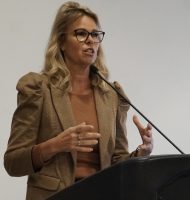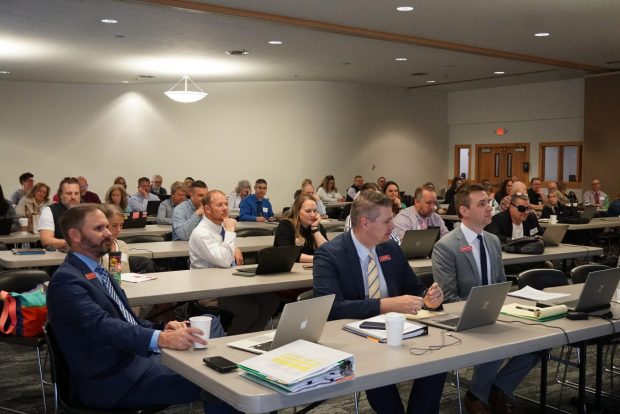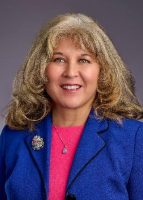State superintendent Debbie Critchfield accomplished one of her top priorities this legislative session: compensating school districts for a shift back to attendance-based funding. But she fell short on two other goals — efforts to modernize the state’s archaic funding formula.
The Republican recently wrapped up her second legislative session as the state’s top public school leader. Her work was largely overshadowed by a blockbuster school facilities funding bill — Gov. Brad Little’s initiative — and by high-profile partisan issues tied to education, like pronouns and library books.
But in the background, Critchfield and her Department of Education team focused on K-12 school finances. They helped secure $145 million to plug a budget hole left by the state’s reversion to attendance-based funding. And Critchfield pushed for incremental changes to the funding formula that would have incorporated a per-student metric and tied some money to outcomes — to no avail.
Still, Critchfield said that “by and large, it feels like a good year.” She spoke to Idaho Education News last week amid her annual post-session roadshow. She’s traveling the state explaining to local administrators what they can expect after a chaotic legislative session for education.
As for Critchfield’s own goals, here’s what she accomplished, and didn’t, this legislative session. To listen to the full interview, click here.
Accomplished: Filling attendance-based funding gap
Critchfield’s showpiece accomplishment was filling a K-12 appropriation gap left by the reversion to a funding formula based on average daily attendance.
The attendance-based metric was reimplemented last year, after a few years under an enrollment-based metric that provided schools more money during the COVID-19 pandemic. The reversion left a $145 million gap between what the attendance-based formula produced and what the enrollment metric would have generated.

At least in the public view, Critchfield’s request to make districts financially whole was uncontroversial. But she said it took a lot of effort convincing lawmakers to trust the department’s data estimating where the gap would be at the end of the school year.
In December, Critchfield asked the Legislature for $162 million in discretionary spending to plug the hole. That was based on attendance data at the time, but more recent February data brought the number down to $145 million, and more attendance data will come in later this spring.
Budget-setting lawmakers called Critchfield’s request a moving target. And legislative budget analysts noted that declining public school enrollment also contributed to some of the lost funding.
“We were able to work through that in a way that got people to believe in the numbers that we were putting out there,” Critchfield said.
Ultimately, the Legislature approved $105 million in discretionary funding that will go to school districts in the coming weeks. Another $40 million will be evenly divided between the Career Ready Students workforce training program and the school facilities fund, a state sales tax-funded account that helps school districts pay off bonds and levies.
Critchfield touted that most of the money went to discretionary coffers. Districts have flexibility on spending those funds but most put them toward operational costs, such as teacher and staff pay.
“We worked really hard on this,” Critchfield told school administrators during her roadshow stop in Boise. She also credited department staff and advocates from the Idaho School Boards Association and Idaho Education Association for pressing to get the money. “We had requested in our budget that all of the difference go into discretionary. That just wasn’t to be.”
There could be a bonus, as well. Attendance data isn’t finalized until the end of the school year, and if the funding gap increases by the end of the year, the difference will be added to discretionary funding.
Critchfield also shared the “bad news” with the administrators Friday: the funding is one-time. While local school leaders in recent years have asked for a permanent enrollment-based formula, there doesn’t appear to be an appetite for that in the Legislature.
Instead, Critchfield and other education policymakers have searched for ways to respond to districts’ needs by modernizing the funding formula gradually.
Meanwhile, districts like Idaho Falls and Coeur d’Alene are grappling with shortfalls of more than $4 million, and have pointed to reduced state funding as a contributing factor.

Failed: Outcomes-based funding pilot
Critchfield, 54, is a former substitute teacher and local school board member from Cassia County. She was appointed to the State Board of Education in 2014 by former Gov. C.L. “Butch” Otter and served as board president from 2019 to 2021.
In 2022, Critchfield handily won the general election after defeating incumbent Sherri Ybarra and former Democratic state lawmaker Branden Durst in a three-way Republican primary.
During the competitive GOP race, Critchfield slammed Ybarra — who had failed to accomplish many of her legislative goals — for losing the Legislature’s trust. Critchfield promised to reestablish confidence and build consensus between local and state education leaders.
This session showed there’s still work to do. Two of Critchfield’s three priorities failed to garner necessary support — one due to a breakdown in negotiations, and the other in a fashion that still confounds the superintendent.
House Bill 595 would have moved $40 million of K-12 spending into an outcomes-based pilot, tying the money to performance in fifth- through eighth-grade math, and college and career readiness.
It’s an idea that conservatives have long supported: using funding to drive student achievement priorities. The legislation checked all the boxes, Critchfield said, and was “budget neutral,” meaning it used funds that had already been set aside for schools.
But Republicans on the Senate Education Committee killed the bill in a 6-3 vote with no explanation from the opponents. Critchfield said she still doesn’t know why. “I’ve scratched my head a lot on that one. We had education folks around the state say ‘What happened? This was about as conservative as you can get?’”
Critchfield speculated that the opposition may have been more personal than practical. The Senate committee vote happened just a few hours after a House panel rejected a controversial bill to create a tax credit program for private school tuition. All six of the “no” votes are proponents of “school choice,” a loose heading of proposals directing taxpayer funds to private education.
“Was that retribution to public schools? Without having had specific conversations with people, I’m left to speculate.” — State superintendent Debbie Critchfield, reflecting on the failure of her outcomes-based funding pilot.

“Was that retribution to public schools?” Critchfield said. “Without having had specific conversations with people, I’m left to speculate.”
There were earlier signs of resistance to outcomes-based funding, however. Twenty-eight House Republicans — including several members of GOP leadership — voted against the bill before it went to the Senate. Debate centered on skepticism that the new spending would actually move student achievement.
Sen. Lori Den Hartog didn’t mention the private school tax credits when asked about her opposition to the outcomes funding legislation. She was a co-sponsor of the school choice bill, and for years, has pushed similar proposals that haven’t crossed the finish line.
Den Hartog said she supports tying school funding to outcomes, but the proposal “seemed out of order,” coming before broader changes to the school funding formula. First, the state should move toward a student-based funding model, as opposed to the current resource-based model, which appropriates money based on the cost of resources like staff and curriculum.
“It seemed like we were adding one more thing that, ultimately, would then need to be restructured again with the whole underlying formula,” said Den Hartog, R-Meridian.
Failed: Per-student funding formula reform
Critchfield, Den Hartog and Rep. Wendy Horman, R-Idaho Falls, introduced a bill to create a per-student funding metric, but it also failed in committee — this time in the House and without a hearing.
Idaho is one of 17 states that uses a resource-based K-12 funding approach, according to EdBuild, a former nonprofit that highlighted school funding dispatiries. Idaho gives schools money through “support units,” which essentially represent the cost to operate a classroom. Education leaders have long sought to reform the formula because it often fails to account for students who require additional resources, including those with special needs.
House Bill 718 was an incremental step in that direction. The bill would have shifted schools’ discretionary funding — about 12% of the K-12 budget — to a “per-student” model, providing districts with a base amount of money for each student.
“It was just too much, too late in the session.” — Rep. Julie Yamamoto on a bill that would have distributed some school funding through a per-student formula.
The bill’s introduction was “precarious” from the get-go, Critchfield said. Early in the session, she teased a proposal that would add weights to the formula, giving districts more money for students meeting certain characteristics. For instance, special education students, at-risk students and English-language learners would generate a higher distribution.
“We ran spreadsheet after spreadsheet,” Critchfield said. “We had put together a very thoughtful approach that included a lot of good math, (so) we could honor the different parts of what it takes to put a classroom together that support units alone did not capture.”
But the weights created a handful of losers, which led to a breakdown in negotiations. While most districts would have benefitted from the new formula, eight districts and charter schools would’ve lost a combined $200,000.

At the same time, excluding the weights didn’t sit well with House Education Committee members who were part of Critchfield’s 2023 formula task force that inspired the per-student funding idea. “The feedback to me was ‘bring back the policy bill…that we worked on with the stakeholders and we all agreed to,’” Critchfield said.
The House committee introduced the bill in the waning weeks of the session but didn’t vote on it. “It was just too much, too late in the session,” said Rep. Julie Yamamoto, R-Caldwell, who chairs House Education.
What’s next?
Along with outcomes funding, Critchfield said she plans to bring back the formula proposal next legislative session.
“We are committed to having the state budgeting reflect the students that you have,” she told school administrators in Pocatello during the post-session event there. “We’re committed to bringing it back and fighting hard for it.”
Yamamoto and Sen. Dave Lent, who chairs the Senate Education Committee, said those proposals could be successful if Critchfield builds consensus earlier in the session. For the most part, lawmakers trust Critchfield and her priorities, Yamamoto said, but “some people are leery by nature.”
Despite the losses this session, Yamamoto and Lent praised Critchfield’s effort to seek out feedback from local education leaders and represent their concerns in the Statehouse — particularly as major changes, like new facilities money and new minimum instructional days, are steaming toward them. Lent, R-Idaho Falls, recalled the adage “seek first to understand, then to be understood.”
“She does a good job of that,” he said.

In recent weeks, Critchfield has been traveling the state and talking to school administrators about what happened this session. Here are some of the highlights from her speaking tour:
House Bill 521 implementation. The Department of Education is helping local school leaders unpack the sweeping facilities bill that’s set to deliver $1 billion to districts next school year. Critchfield said she hopes to temper expectations about when the money will arrive. Districts may get a small portion of the money by the end of August, but it will take time for the Idaho Building Authority to secure the bonds needed to distribute the money.
Chronic absenteeism. Critchfield said she wants to spur a statewide discussion about addressing chronic absenteeism. The department regularly fields pleas from districts across the state about enforcing attendance policies, she said. “They’re saying help us know what to do.”
Mental health. Critchfield said her team has been working for more than a year on addressing mental health issues among students and schools staff. However, the department recognizes that “we’re not trying to turn our teachers into therapists, and that our schools are not hospitals or counseling centers,” she said in Pocatello.
Special education funding. Also in Pocatello, Critchfield said her department is working to identify the scope of a statewide gap in special education funding before asking the Legislature to address it. “We want to wrap our minds around what the real problem is,” she said. “The ask that we make needs to be the right, accurate one, rather than ‘Here’s our target range.’”
Reporter Carly Flandro contributed to this story.
